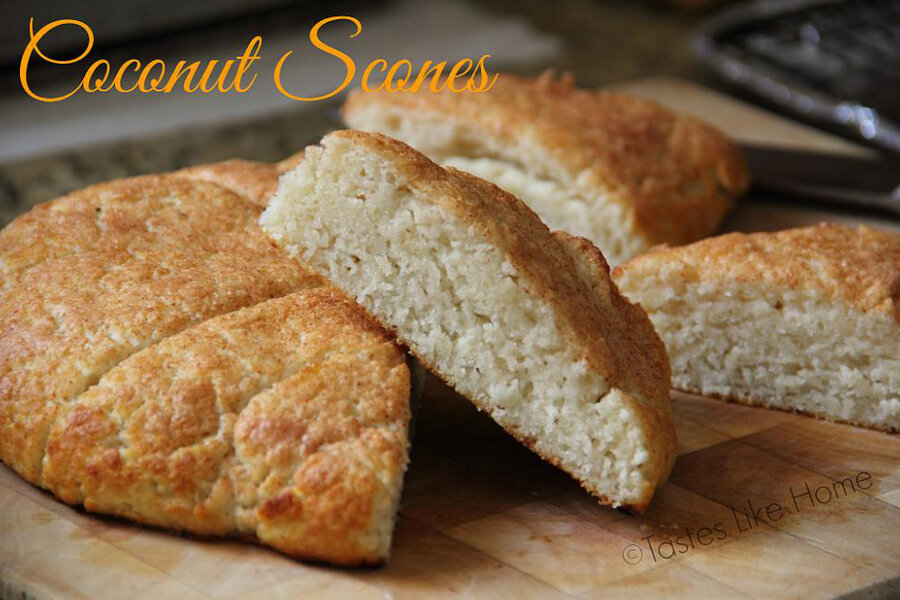Coconut scones
Loading...
Lately I have been testing various recipes using coconut oil made by a small Guyanese farmer here in Barbados and the results have been truly delicious. The textures and flavors of the baked goods have been outstanding. So far I've used the coconut oil to make pastries – sweet and savory and one of my all-time favorite things, scones.
I start by pouring the freshly made,freshly bought coconut oil into a container and refrigerating it overnight. In no time, it is rock solid, harder than very cold butter. It is from this stage that I chop off (too hard to cut) what I need, weigh, and then go to work. I simply replace the hardened/solid coconut oil in place of butter, ounce for ounce.
These coconut scones are not only made with coconut oil but also freshly grated coconut. It has the right amount of sweetness and the cinnamon sugar coating creates a delicate crust.
Coconut scones
Yields 8
It is very important that you read all the notes below before attempting this recipe.
For dough
2 cups all-purpose flour, plus extra for work surface
1 tablespoon baking powder
1/2 teaspoon ground cinnamon
3 tablespoons white sugar
1/8 teaspoon salt (a pinch)
1 cup freshly grated coconut, cold
4 ounces cold, hardened coconut oil, chopped into pieces
3/4 cup cold whole milk
For topping
1/4 cold whole milk
2 tablespoons castor sugar
3/4 teaspoon ground cinnamon
1. Line a baking sheet with parchment paper and set aside.
2. Shift the flour and add it to the bowl of a food processor along with the baking powder, cinnamon, sugar and salt. Pulse a few times to mix well.
3. Add coconut and pulse to mix.
4. Add hardened coconut oil and pulse until the mixture is coarse.
5. With the processor running, pour in the milk. Open the cover and test the dough by gathering a little of it with your fingers, if it comes together, it is done, if not, replace the cover and add a little more milk until it can come together easily. Do not overwork the dough. It is supposed to be a little crumbly but not dry.
6. Flour a work surface and turn out the contents of the bowl onto the surface. Flour your hands and bring to dough together patting it into a thick 6-inch disk.
7. Carefully transfer the disk to the lined baking sheet and put in the freezer for 15 to 20 minutes or until hardened (longer if in refrigerator). Meanwhile, preheat the oven to 425 degrees F., and mix together the cinnamon and sugar for the topping and set aside.
8. Remove the pan from the freezer/refrigerator, cut into dough into wedges. Brush with milk and sprinkle with cinnamon sugar.
9. Bake for 18 to 20 minutes or until scones and brown and the top crusty.
10. Rest in pan for 5 minutes then transfer to a wire rack to cool. Serve warm.
Notes
- This recipe requires that the liquid coconut oil be refrigerated overnight so it gets cold and very hard. The oil once hardened does not cut as easily as butter and that is because it is a pure fat without water (butter has in some water). Therefore, you will have to chop off large chunks.
- The fresh coconut once grated should be refrigerated too so that it is very cold.
- You can try substituting the fresh coconut for flaked coconut, however, use only the unsweetened version and just like the fresh coconut, put it the refrigerator to get really cold before using it.
- With regards to the topping, if you do not have castor sugar, which is a finer grain of the regular white granulated sugar, then use the regular granulated sugar.
- Hardened coconut oil reacts differently in various temperatures than butter, therefore, when you make the dough and have patted it into a round disk, put it in the freezer (right on the lined baking sheet) for 15 to 20 minutes before cutting into wedges, adding the topping and baking. This is to firm up the dough. Work quickly when making these scones.
- I highly recommend that you use a food processor to make the dough as it would take too long to make it by hand causing the hardened oil to melt. Using a pastry blender might prove difficult as well because of how hard the oil is once refrigerated. You may need to use a little more milk depending on your location.
- I have not tested this recipe using regular butter but you can certainly substitute the hardened coconut oil with cold unsalted butter. The coconut flavor would be less, of course.
- These scones have the right amount of sweetness and do not need jam or jelly to accompany it but if you have a sweet tooth, then go right ahead.








